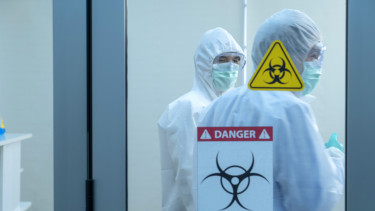Hungarian Medical Chamber sounds the alarm again - Hospitals getting filled fast

MOK says hospitals getting saturated
Hungarian authorities today reported 178 Covid deaths for Tuesday. Putting this figure into perspective, the Hungarian Medical Chamber (MOK) said this translates into 1,000 deaths per week, which is the population of a small village, and only if fatalities stop rising. But they will not.
There are 565 coronavirus patients on ventilator, which implies at least twice as many patients in severe condition that require intensive care – should there still be room for them, the MOK said in a press release.
Here is Portfolio’s report on the latest Covid data, including their comparison to the previous weeks, the same period of 2020, and a regional snapshot.

In the upper chart we compared the figures of 16 November to one, two, three, and four weeks earlier. The chart below that shows the week-on-week changes. The red cells make it evident that the epidemiological situation has been worsening at a more alarming rate in almost every aspect than in the base period.
We have already written about the growing load on hospitals, and experts keep warning about it almost every day.


The MOK said more than 10% of the daily new COVID-19 cases need medical attention, i.e. hospitalisation, which means there could be a lot more infections than what the official numbers show. Even a few hundred new hospitalisations and a 10% growth in the number of Covid patients in hospital are an immense burden on ambulances and the admitting hospitals.
Even working flat out emergency departments are drowning in patients; they are transforming more and more wards to treat Covid patients, transferring ophthalmologists, urologists, surgeons and the nurses from those departments, the MOK described what is going on in hospitals right now.
The chamber continues:
intensive care units (ICUs) are getting saturated, although new and new wards are added to them.
The MOK says this should not come as a surprise, as we have seen the dramatic surge in the number of new cases, but apart from a vaccination campaign that started well and then petered out no meaningful protective measure was put in place in Hungary.
Beyond a certain point it becomes irrational to add more ICUs because
regardless of the sufficient number of machines staff has only become scarcer since the previous wave.
Health care personnel “got sick and died, they burnt out and quit. Without an adequate number of professional staff there is no real intensive therapy,” said the MOK.
About the new ministerial decree
Under a new ministerial decree published the other day, for every 20 ICU beds there must be one specialised doctor (we sincerely hope that minister Kásler meant an anaesthesiologist/ICU specialist), a doctor (any kind?!) and five nurses, the MOK reminded.
“The decree does not specify what qualifications the nurses must have and is really quiet about the necessary physiotherapists, physical therapists, further staff required to move the often overweight patients. One nurse per four patients, or – in case of a four-bed room – one nurse per room. In case of smaller rooms, not each of them will have a nurse.”
The MOK said
this is a serious dilution of professional standards and regulations, and translates into a tense rush instead of actual intensive care.
The biggest problem, it added, is that even this ratio could not be secured in various hospitals during the previous wave, and the risk of that occurring again is on the rise. What it led to was an even internationally high ratio of ICU patients dying, and it will not be different this time, either.
The profession agrees that the high fatality rate is linked not to the lack of machinery, rather than to the shortage of doctors, nurses and other specialists.
No ventilator for elderly, seriously ill patients
The MOK pointed out that the saturation of ICUs brings about a backlog of patients in their former places of hospitalisation. There is no place to pass on patients that struggle for air and whose condition is worsening.
Most eldelry patients in severe condition die here because the number of ICU beds is limited.
Shortcomings of the system
The MOK has once again listed systemic shortcomings, including:
- unsettled on-call fees;
- overworked staff struggling to save lives in night shifts, on weekends and during holidays for less than their hourly rate;
- insufficient and unfair wage hike for specialists;
- the ‘noise’ of the struggle cannot be heard outside hospital walls (because health care workers are not allowed to talk to the press, or they simply don’t want to in fear of their job). As no information is ‘leaked’ (reporters are not allowed inside, and recordings are prohibited in Covid wards too) the public does not pay attention to the pandemic. They go about their lives as they have no care in the world, attending soccer games, concerts, party gatherings without wearing face masks; restaurants and pubs are open to the public without any restriction. The weight of that is felt not by them but by those working in health care. The physical and psychological load on them is becoming ever greater.
- health care workers do not feel respected;
- “There’s something dramatically discordant in the fact that while someone is ordered far from their home […] and work 12 to 24 hours hard for patients, while others go and have fun and relax en masse without restrictions, potentially infecting and getting infected.”
Recommendations
“You can ask the health care system and its workers to make sacrifices again and again. You can do that for the third time, for the fourth time. This is really our job. But you’d better make right by us!,” the chamber said.
They argue that without that the already bloody public health care system will be in ruins by the end of the pandemic.
The chamber ensured that “until then we will treat everyone to the best of our knowledge and power, but
beyond a certain point, it will be done in a highly compromise way reminiscent only of wartime conditions.
The MOK says this is not up to them, but on government-imposed regulations and the people’s willingness to follow the rules.
“If the Hungarian society does not want a lot of dead by Christmas, if it wants to show its appreciation to the heroes fighting for it then they need to
- settle the issue of on-call fees;
- raise specialists’ wages considerably;
- start to meaningfully address the problems of health care; and
- most importantly, together we need to slow down the increase in the number of [COVID-19] cases, the flooding of hospitals, otherwise a host of families will have an extremely forlorn Christmas!”
MOK recommends restriction measures
The chamber is convinced that in order to do so:
- mask-wearing must be made compulsory in all indoor public spaces (shopping malls, stores, cinemas, theatres, etc.)
- mass events must be banned (and not just medical conferences that have just been blacklisted by Minister of Human Capacities Miklós Kásler on grounds of the pandemic);
- entry to non-essential venues (pubs, restaurants, theatres, cinemas) must be conditional to having immunity certificates (i.e. having the appropriate number of COVID-19 doses within six months) or negative PCR tests;
- remote work / work from home needs to be supported;
- on an individual level we need to social distance and wash hands well and regularly.
The MOK, chiming together with various other experts, is stressing that relying solely on vaccines will simply not be enough.
“We know that vaccines are the most important in the long term. But we are also aware that it takes weeks after the jab to develop protection, while the pandemic is rampant now. Until then the defensive measures need to be kept in place,” underlined the medical chamber.
It is only by the simultaneous use of these tools that we will have a chance to lower the number of the casualties of this pandemic both in the short and in the long terms.
What is the top capacity of Hungarian hospitals?
We have repeatedly warned that the load on and the general situation of hospitals is getting worse, as the spread of coronavirus is similar to what we witnessed in the third wave, and the rate at which the number of hospitalisations grow is even higher. Yet, the government is reluctant to tighten anti-pandemic measures, even such simple ‘restriction’ (restriction? seriously? give us a break!) as compulsory mask-wearing everywhere indoors. Meanwhile, other countries even in this region are putting one restriction measure after another in place. Here are a couple of countries in Europe where the number of new COVID-19 cases has surged and that have either implemented new lockdown measures or are seriously considering them.
Previously, we have estimated that accepting the top ventilation capacity to be 900 beds (beyond which it would be wartime operation, according to reports from the frontline), then on the extremely simplified assumption of having 200 people with other diseases than Covid on ventilator
the Hungarian health care system has reached 85 to 90% of its top capacity.
Given the speed at which coronavirus is spreading (the Delta variant is more contagious than the previous strains), and that it would take weeks for any restriction to start alleviating the pressure on hospitals, we can be certain that hospitals will reach the top capacity.
Gergely Gulyás, cabinet chief of Prime Minister Viktor Orbán, has recently said the top capacity of ICU beds with ventilator is 5,000 therefore, officially and on paper, more patients in severe condition could be put on ventilator. In that case, however, there are the constraints listed by the MOK (e.g. shortage of qualified staff) and the grave consequences that would ensue that need to be taken into consideration.
Cover photo: MTI/Tamás Vasvári







